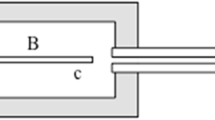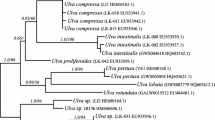Abstract
The hydraulic resistance (the reciprocal of the hydraulic conductivity Lp) Lp−1 was measured in cells of Chara corallina by the method of transcellular osmosis. Treatment of cells with 100 mM KCl decreased Lp−1 significantly. Subsequent treatment of the cells with 70 mM CaCl2 recovered the decreased Lp−1 to the original value. To know whether K+ or Ca2+/Mg2+ acts on the cell wall and/or the membrane, the hydraulic resistances of the cell wall (Lpw−1) and that of the membrane (Lpm−1) were determined in one and the same cell. For this, a pair of cells (twin cells) were made from an internodal cell, one used for measurement of Lp−1 and the other used for the measurement of Lpw−1. From Lp−1 and Lpw−1, Lpm−1 was calculated. Both Lp−1 and Lpw−1 were decreased by K+, while Lpm−1 was not affected by K+. The same result was obtained with 5 mM EGTA. Lpw−1 was decreased more than it was by KCl but Lpm−1 remained constant after EGTA treatment. The recovery of the K+-decreased Lp−1 with Ca2+ can be explained exclusively by the recovery of Lpw−1 with Ca2+. The Ca2+ recovery of Lpw−1 was observed in the intact cell wall but not in the cell wall tube isolated from an internodal cell. The different response to Ca2+ between the intact cell wall and the isolated cell wall was discussed in relation to the tension in the cell wall which may be an important factor for the ionic regulation of hydraulic conductivity.





Similar content being viewed by others
Data availability
N/A
Code availability
N/A
References
Cabañero FJ, Martinez-Ballesta MC, Teruel JA, Carvajal M (2006) New evidence about the relationship between water channel activity and calcium in salinity-stressed pepper plants. Plant Cell Physiol 47:224–233
Carpita NC, Gibeaut DM (1993) Structural models of primary cell walls in flowering plants: consistency of molecular structure with the physical properties of the walls during growth. Plant J 3:1–30
Dainty J, Ginzburg BZ (1964) The measurement of hydraulic conductivity (osmotic permeability to water) of internodal characean cells by means of transcellular osmosis. Biochim Biophys Acta 79:102–111
Gerbeau P, Amodeo G, Henzler T, Santoni V, Ripoche P, Maurel C (2002) The water permeability of Arabidopsis plasma membrane is regulated by divalent cations and pH. Plant J 30:71–81
Kamiya N, Kuroda K (1956) Artificial modification of the osmotic pressure of the plant cell. Protoplasma 46:423–436
Kamiya N, Tazawa M (1956) Studies on water permeability of a single plant cell by means of transcellular osmosis. Protoplasma 46:394–422
Kamiya N, Tazawa M, Takata T (1962) Water permeability of the cell wall in Nitella. Plant Cell Physiol 3:285–292
Kishimoto U, Nagai R, Tazawa M (1965) Plasmalemma potential in Nitella. Plant Cell Physiol 6:519–528
Kitasato H (1968) The influence of H+ on the membrane potential and ion fluxes of Nitella. J Gen Physiol 52:60–87
Kiyosawa K, Tazawa M (1977) Hydraulic conductivity of tonoplast-free cells of Chara cells. J Membr Biol 37:157–166
Küster E (1956) Die Pflanzenzelle 2nd. Ed. Gustav Fischer Verlag, Jena pp.986
Maurel C, Tacnet F, Güclü J, Ripoche P (1997) Purified vacuolar and plasma membrane exibit dramatically different water permeability and water channel activity. Proc Natl Acad Sci U S A 94:7103–7108
Maurel C, Verdoucq L, Luu D-T, Santoni V (2008) Plant aquaporins: membrane channels with multiple integrated functions. Ann Rev Pl Biol 59:595–624
Proseus TE, Boyer JS (2006) Calcium pectate chemistry controls growth rate of Chara corallina. J Exp Bot 57:3989–4002
Proseus TE, Boyer JS (2007) Tension required for pectate chemistry to control growth in Chara corallina. J Exp Bot 58:4283–4292
Shimmen T (2001) Studies on electrogenesis under high K+ concentrations in internodal cells of Chara corallina. J Plant Res 114:59–66
Shimmen T, Kikuyama M, Tazawa M (1976) Demonstration of two stable potential states of plasmalemma of Chara without tonoplast. J Membr Biol 30:249–270
Takamine N (1940) On the plasmolysis form in Allium cepa with special reference to the influence of potassium ion on it. Cytologia 10:302–323
Tazawa M (1957) Neue Methode zur Messung des osmotischen Wertes einer Zelle. Protoplasma 48:342–359
Tazawa M, Kamiya N (1965) Water relations of characean internodal cell. Ann Rep Biol Works Fac Sci Osaka Univ 13:123–157
Tazawa M, Asai K, Iwasaki N (1996) Characteristics of Hg- and Zn-sensitive water channels in the plasma membrane of Chara cells. Bot Acta 109:1–9
Tazawa M, Katsuhara M, Wayne R (2021) Age-dependence of hydraulic resistances of the plasma membrane and the tonoplast (vacuolar membrane) in cells of Chara corallina. Protoplasma 258:793–801
Author information
Authors and Affiliations
Contributions
MT designed the research, performed the experiments, and wrote the first draft of the manuscript. MK and RW critically reviewed the manuscript. The manuscript was revised by all authors.
Corresponding author
Ethics declarations
Ethics approval
N/A
Conflict of interest
The authors declare no competing interests.
Additional information
Handling Editor: Peter Nick
Publisher’s note
Springer Nature remains neutral with regard to jurisdictional claims in published maps and institutional affiliations.
Supplementary Information
Below is the link to the electronic supplementary material.
Rights and permissions
About this article
Cite this article
Tazawa, M., Katsuhara, M. & Wayne, R. Calcium control of the hydraulic resistance in cells of Chara corallina. Protoplasma 260, 299–306 (2023). https://doi.org/10.1007/s00709-022-01772-z
Received:
Accepted:
Published:
Issue Date:
DOI: https://doi.org/10.1007/s00709-022-01772-z




